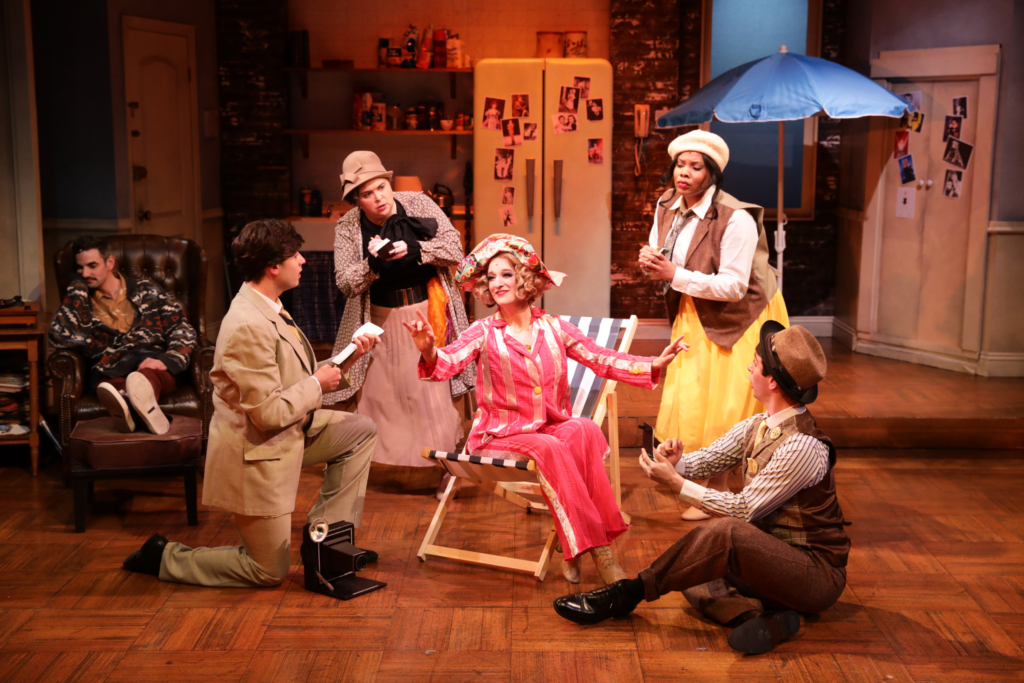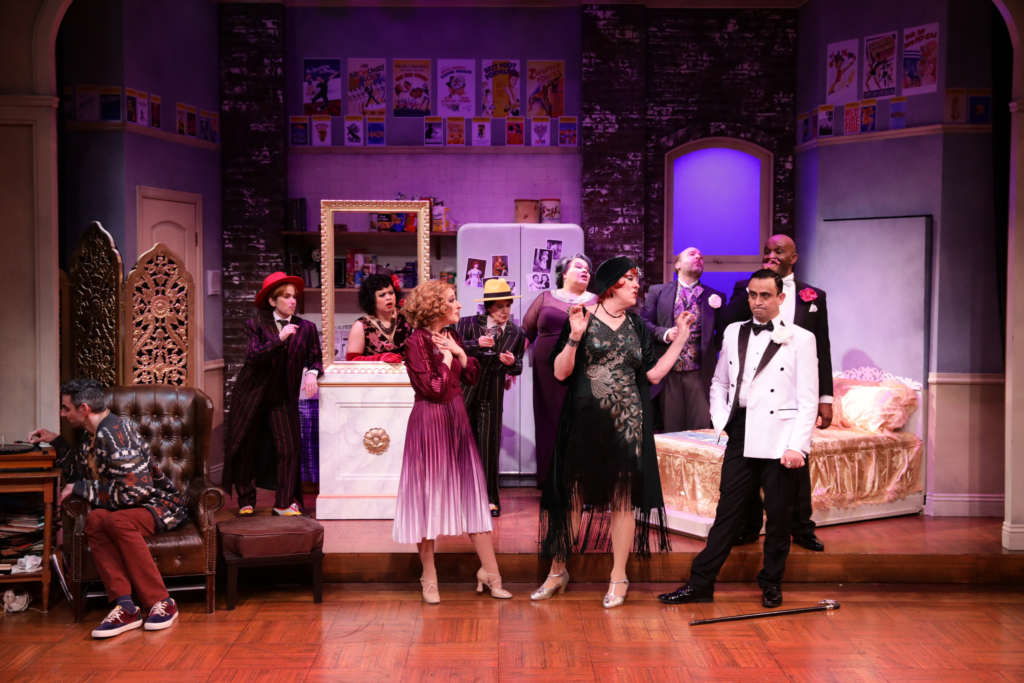
Production photo. Photo by Mark. S. Howard.
Presented by The Lyric Stage Company of Boston
Music & Lyrics by Lisa Lambert & Greg Morrison
Book by Bob Martin & Don McKellar
Directed and choreographed by Larry Sousa
Music direction by Matthew Stern
April 5 – May 12, 2024
Lyric Stage Boston
140 Clarendon St, Boston, MA 02116
One hour and forty-five minutes with no intermission
Content advisory: Comedic sexuality and alcohol use.
Review by Sean French-Byrne
BOSTON, Mass. – Metanarrative is the word of the day in The Lyric Stage Company of Boston’s The Drowsy Chaperone. Opening in darkness and lingering in that moment of tension, as the voice of the Man in the Chair rises out of the darkness and muses about theater, from beginning to end The Drowsy Chaperone presents a sardonic yet compassionate love letter to the way that theater touches our lives.
Buoyed from beginning to end by the charismatic performance of Paul Melendy as the Man in the Chair, this production evokes the experience of being taken by the hand and shown the pieces of a play that shine. It is imbued by that friend’s (occasionally morbid) fascination.
“It’s my favorite show, and I’ve never even seen it,” the Man in the Chair explains towards the end of the production, contemplating the set of records.
As I was leaving the theater with my friend, she commented that the same was true of countless shows she experienced growing up. Often, audience experiences of the glitzy, generation-defining shows that happen on the other side of the country, or the world, or before we are born, are limited to audio From that audio we dream up the rest. It is that dreamy nostalgia that The Drowsy Chaperone seeks to invoke.
The set, designed by Cameron McEachern, is the star of the show: the Man in the Chair’s modest but carefully decorated apartment, plastered with carefully lined up theater posters. At the beginning, the Man in the Chair summons in his mind the characters of the titular Drowsy Chaperone, an oft-listened-to-cast recording from a 1920s musical production, by putting on a record. They romp through the confines of his apartment, appearing from inside the fridge, popping down pieces of the wall to form beds, and bringing the glitz of an imagined 1920s (a fun decade, for the rich anyway, says the Man in the Chair) into the subdued world of everyday life.
The striking contrast between the mundane, lived-in reality of the Man in the Chair’s world – the blocky landline phone that rings intermittently throughout the play, cutting through the sweeping romp of the music, the record player, and canned air, the protein bar and mugs of tea – and the broadly-drawn, bright world of the cast recording beautifully underlines the show’s concept. I was tremendously impressed by the way the set and costume design starkly drew two different worlds.
The crisp choreography of Larry Sousa also goes a long way towards supporting the threads of metanarrative. Of particular note is a moment midway through the show, when the music is thrown into a loop and the cast stutters through a moment again and again and again as the Man in the Chair’s record skips.

Production photo. Photo by Mark S. Howard.
Each actor is playing a double reality; the character from The Drowsy Chaperone, and the character of the 1920s actor playing a role in The Drowsy Chaperone. These layers of narrative work best when they are highlighted by the cast. In moments such as when Janet Van De Graaf (Joy Clark), slinks off the stage when the powerhouse diva of the Chaperone (Maureen Keiller), a well-loved and adored Dame of the stage, steals the spotlight. The moments when the fictional actors bleed through the performance of their fictional characters make the performances a nuanced delight to see.
The show soars enthusiastically from one musical number to the next, interspersed, paused, and occasionally sped up by the Man in the Chair’s commentary. The sound mixing is off-balance between the band and the actors. The volume of the live music occasionally drowned out the actors’ voices. This meant some songs were difficult to decipher.
The fictional Drowsy Chaperone, as the Man in the Chair explains, is flawed, silly, and deeply important to him. The cast, designers, and crew of The Lyric have done a beautiful job telling a story about art being both silly and deeply, personally important. Watching the Drowsy Chaperone felt like a friendly plunge into the most loved aspects of a piece of art. It’s the perfect interlude for a gloomy Sunday afternoon.
